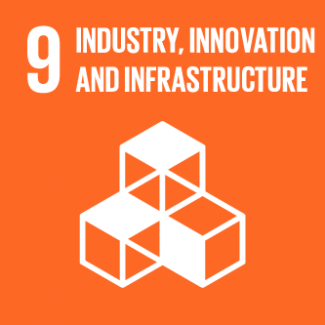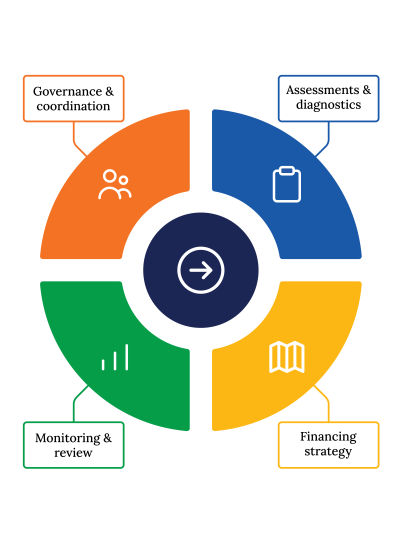IT Outsourcing and Remote Workforce Solutions





Business Model Description
Establish and operate an IT outsourcing firm specializing in software development, cybersecurity, and cloud infrastructure for European clients. Provide services through remote teams, leveraging North Macedonia’s skilled workforce and competitive pricing. Implement AI-driven project management and cybersecurity solutions while expanding via strategic partnerships and white-label services.
Expected Impact
The IT outsourcing sector in North Macedonia creates high-value jobs, drives digital inclusion, and fosters gender equality
How is this information gathered?
Investment opportunities with potential to contribute to sustainable development are based on country-level SDG Investor Maps.
Disclaimer
UNDP, the Private Finance for the SDGs, and their affiliates (collectively “UNDP”) do not seek or solicit investment for programmes, projects, or opportunities described on this site (collectively “Programmes”) or any other Programmes, and nothing on this page should constitute a solicitation for investment. The actors listed on this site are not partners of UNDP, and their inclusion should not be construed as an endorsement or recommendation by UNDP for any relationship or investment.
The descriptions on this page are provided for informational purposes only. Only companies and enterprises that appear under the case study tab have been validated and vetted through UNDP programmes such as the Growth Stage Impact Ventures (GSIV), Business Call to Action (BCtA), or through other UN agencies. Even then, under no circumstances should their appearance on this website be construed as an endorsement for any relationship or investment. UNDP assumes no liability for investment losses directly or indirectly resulting from recommendations made, implied, or inferred by its research. Likewise, UNDP assumes no claim to investment gains directly or indirectly resulting from trading profits, investment management, or advisory fees obtained by following investment recommendations made, implied, or inferred by its research.
Investment involves risk, and all investments should be made with the supervision of a professional investment manager or advisor. The materials on the website are not an offer to sell or a solicitation of an offer to buy any investment, security, or commodity, nor shall any security be offered or sold to any person, in any jurisdiction in which such offer would be unlawful under the securities laws of such jurisdiction.
Country & Regions
- Republic of North Macedonia: Skopje
- Republic of North Macedonia: Pelagonia
- Republic of North Macedonia: Polog
- Republic of North Macedonia: Eastern
- Republic of North Macedonia: Southwestern
Sector Classification
Technology and Communications
Development need
The ICT sector in the Republic of North Macedonia requires enhanced digital infrastructure, increased R&D investment, and a larger skilled workforce to sustain its rapid growth. Strengthening digital skills training, cybersecurity resilience, and cloud computing adoption will enable businesses to scale and improve competitiveness in regional and global markets. (2)
Policy priority
ICT is a cross-sectional strategic priority under NDS 2024-2044 and Smart Specialization Strategy, aligning with EU digitalization and innovation goals. Policies focus on digital transformation, technology exports, AI development, and bridging the skills gap through targeted incentives and workforce training programs. (1, 2)
Gender inequalities and marginalization issues
Despite ICT’s growth, women and marginalized groups remain underrepresented, particularly in high-value technical roles and leadership positions. Addressing this gap requires STEM education initiatives, mentorship programs, and gender-inclusive hiring policies to foster greater diversity and participation. (19)
Investment opportunities introduction
The ICT sector offers high-growth opportunities in broad IT services including outsourcing, AI, and cloud services, supported by government incentives, tax benefits for IT exports, and EU funding programs. The growing demand for digital solutions across industries presents further investment potential in smart infrastructure, automation, and IoT. (20)
Key bottlenecks introduction
Challenges include a shortage of skilled professionals, limited access to capital for startups, slow digital adoption in traditional industries, and gaps in regulatory alignment with EU digital standards. Improving educational alignment with industry needs, expanding digital infrastructure, and reducing bureaucratic barriers will be critical (20, 21)
Technology
Development need
The Software & IT Services subsector requires scalable digital infrastructure, advanced AI & cloud solutions, and a highly skilled workforce to sustain rapid expansion. Strengthening R&D capabilities, startup ecosystems, and university-industry collaboration will enhance North Macedonia’s position as a competitive regional tech hub. (2)
Policy priority
Fully aligned with the Smart Specialization Strategy and NDS, the Government prioritizes digital transformation, IT outsourcing, cybersecurity, and AI-driven innovation. Policies focus on tax incentives, workforce upskilling, and EU market integration to strengthen global competitiveness. (1, 2)
Gender inequalities and marginalization issues
Women and marginalized groups remain underrepresented in technical roles, leadership, and entrepreneurship within ICT. Expanding STEM education programs, mentorship initiatives, and diversity-focused hiring policies is crucial for fostering inclusive growth and reducing gender disparities in the digital economy. (7)
Investment opportunities introduction
High-growth opportunities are emerging in advanced sub-sectors such as cybersecurity, fintech, and frontier technologies including AI, blockchain, and IoT. These areas are drawing attention from investors due to rising global demand and the country’s growing tech talent. (2)
Key bottlenecks introduction
Challenges include a shortage of experienced professionals, slow access to venture capital, regulatory gaps in data protection, and digital adoption barriers in traditional industries. Addressing talent retention, expanding digital infrastructure, and streamlining investment procedures will be key to long-term subsector growth. (22)
Software and IT Services
Pipeline Opportunity
IT Outsourcing and Remote Workforce Solutions
Establish and operate an IT outsourcing firm specializing in software development, cybersecurity, and cloud infrastructure for European clients. Provide services through remote teams, leveraging North Macedonia’s skilled workforce and competitive pricing. Implement AI-driven project management and cybersecurity solutions while expanding via strategic partnerships and white-label services.
Business Case
Market Size and Environment
> USD 1 billion
5% - 10%
In 2023, North Macedonia's ICT service exports were reported at $601 million, highlighting the sector's significant contribution to the national economy. (3)
The ICT market in North Macedonia surpassed USD 1 billion in 2020, making the IT industry one of the most profitable and prosperous industries. (11)
The European IT outsourcing market is projected to experience a CAGR of 7.93% between 2025 and 2029. (12)
Indicative Return
10% - 15%
Profit margins of 12-16% in the sector indicate solid ROI, particularly in software and cloud services. (6)
Investment Timeframe
Medium Term (5–10 years)
A small IT outsourcing firm can break even in 4-7 years, depending on size and profitability. (6)
Firms with high-value services (AI, cybersecurity, fintech) may achieve even faster payback (4-5 years), based on key stakeholder interviews. (6)
Ticket Size
< USD 500,000
Market Risks & Scale Obstacles
Capital - Limited Investor Interest
Market - High Level of Competition
Business - Supply Chain Constraints
Impact Case
Sustainable Development Need
The IT outsourcing sector retains skilled professionals in North Macedonia by offering competitive salaries and remote work opportunities, reducing emigration and unemployment among young graduates. (4)
Expanding IT infrastructure and digital skills training can boost innovation, economic diversification, and SME competitiveness, supporting country’s digital transformation goals. (4)
IT services reduce paper usage, energy-intensive business travel, and inefficient processes by promoting cloud computing, AI-driven automation, and remote work, lowering the overall carbon footprint. (20)
Gender & Marginalisation
Women remain underrepresented in North Macedonia’s IT sector. Targeted STEM education, mentorship programs, and inclusive hiring policies help increase female participation in tech careers. (3)
Expanding digital skills training and remote work opportunities enables rural populations, persons with disabilities, and economically disadvantaged groups to access high-paying tech jobs. (20)
Expected Development Outcome
By integrating energy-efficient technologies and renewable energy, the energy efficiency retrofitting reduces industrial and commercial energy demand, cutting greenhouse gas emissions and supporting North Macedonia’s climate targets.
The IT outsourcing sector creates high-paying jobs, reduces youth unemployment, and retains skilled workers in North Macedonia, fostering a knowledge-based economy and increasing GDP contribution.
By expanding digital literacy programs, STEM education, and remote work opportunities, the sector enhances accessibility for marginalized groups and improves workforce readiness for global markets.
Gender & Marginalisation
The business model supports STEM education, mentorship, and gender-inclusive hiring policies, increasing female representation in IT roles and leadership positions in North Macedonia’s tech industry.
Promotion of remote work and digital skills training enables rural populations, persons with disabilities, and underprivileged youth to access stable, high-paying tech jobs.
Primary SDGs addressed

8.1.1 Annual growth rate of real GDP per capita
Annual growth rate of 3%. (12)
Annual growth rate of 4.7% in line with the NDS 2024-2044. (1)

9.5.1 Research and development expenditure as a proportion of GDP
0.4% of GDP. (1)
Secondary SDGs addressed



Directly impacted stakeholders
People
Gender inequality and/or marginalization
Planet
Corporates
Public sector
Indirectly impacted stakeholders
People
Gender inequality and/or marginalization
Planet
Corporates
Public sector
Outcome Risks
Rapid IT sector growth may outpace local workforce supply, leading to talent shortages, wage inflation, and reliance on foreign workers, making it harder for SMEs to compete for professionals.
Heavy dependence on foreign clients and outsourcing contracts exposes the sector to economic downturns and demand fluctuations, increasing financial instability for local IT firms.
While IT reduces travel emissions, higher energy consumption from data centers, AI processing, and cloud computing may increase carbon footprints unless powered by renewable energy sources.
Impact Risks
If university curricula do not align with industry demands, graduates may lack necessary skills, limiting the impact of IT sector growth on youth employment and economic development.
Without sufficient investment in broadband, cloud services, and cybersecurity, businesses and public institutions may struggle to fully adopt digital transformation, reducing expected benefits.
Heavy reliance on foreign IT outsourcing contracts exposes the sector to economic slowdowns, policy changes, or client withdrawals, reducing job security and business stability.
If data protection laws and IT regulations lag behind EU standards, North Macedonia may face obstacles in accessing international markets and attracting foreign investments.
Women and marginalized groups may struggle to access leadership positions, without STEM education programs, mentorship and workplace diversity policies
Impact Classification
What
IT outsourcing sector creates high-paying jobs, reduces youth unemployment, and strengthens digital infrastructure. It contributes positively to economic growth
Who
Young professionals, university graduates, and marginalized groups (women, rural populations) benefit from new opportunities in IT. Gender disparities in leadership and technical roles persist.
Risk
Lack of aligned curricula, insufficient investment uncoordinated regulations with EU and poor data protection laws.
Contribution
Without targeted government incentives, workforce development programs, and digitalization initiatives, sector growth would slow
How Much
With over 21,000 IT jobs and 37% export growth in 2023, the sector significantly impacts GDP, employment, and digital adoption
Impact Thesis
The IT outsourcing sector in North Macedonia creates high-value jobs, drives digital inclusion, and fosters gender equality
Enabling Environment
Policy Environment
NDS 2024-2044 prioritizes digital transformation as a key pillar for sustainable development, aiming to strengthen ICT infrastructure, foster digital skills, and align regulatory frameworks with EU standards to boost innovation, competitiveness, and inclusive economic growth. (1)
Smart Specialization Strategy identifies priority domains—such as Information and Communication Technologies (ICT)—to drive research, innovation, and economic growth. It also supports the NDS's overarching goal of sustainable development through digital transformation. (2)
Digital Agenda for Western Balkans supports the growth of country's ICT sector by promoting digital infrastructure, skills development, e-governance, and alignment with EU digital regulations, fostering regional integration and competitiveness. (15)
Financial Environment
Financial incentives: North Macedonia benefits from ICT-focused EU funds, which provide strong financial assistance for digital transition and digitalization in Western Balkans. (29, 34, 35)
Fiscal incentives: 0% corporate income tax for ICT companies operating in Technological Industrial Development Zones (TIDZs) for up to 10 years; 0% personal income tax on salaries under certain conditions); reduced VAT rates and customs exemptions for importing ICT equipment (30)
Regulatory Environment
Law on Companies provides a flexible and investor-friendly legal framework that supports the establishment and operation of ICT businesses, including startups and foreign-owned firms. (24)
Law on Electronic Communications underpins the ICT sector by regulating digital infrastructure, ensuring fair competition, and promoting access to high-speed networks and secure electronic services in line with EU standards. (25)
Law on Personal Data Protection, which aligns with the EU General Data Protection Regulation (GDPR), regulates data handling practices, crucial for cybersecurity, cloud services, and fintech operations. (26)
Law on Innovation Activity supports R&D and tech innovation through fiscal incentives and access to national innovation funds (e.g., FITD), and encourages development in frontier technologies like AI and blockchain. (27)
Law on Electronic Documents, Electronic Identification and Trust Services regulates the legal validity to e-documents and e-signatures, as well as facilitates digital transactions and remote business operations in ICT. (28)
Marketplace Participants
Private Sector
Seavus, Endava, Scalefocus, Nextsense– Leading IT outsourcing firms providing software development, AI, and cloud services for global clients.
Government
Ministry of Digital Transformation; Agency for Electronic Communications, Agency for Employment of North Macedonia.
Multilaterals
European Bank for Reconstruction and Development (EBRD), European Investment Bank (EIB), World Bank, UNDP, KfW.
Non-Profit
MASIT (ICT Chamber) ;Startup Macedonia; Women in Tech® Macedonia (16)
Target Locations
Republic of North Macedonia: Skopje
Republic of North Macedonia: Pelagonia
Republic of North Macedonia: Polog
Republic of North Macedonia: Eastern
Republic of North Macedonia: Southwestern
References
- (1) National Development Strategy of the Republic of North Macedonia 2024-2044
- (2) Smart Specialization Strategy of the Republic of North Macedonia
- (3) New Growth of the ICT Industry, MASIT, Skopje, https://masit.org.mk/publications_post/novite-indikatori-pokazhuvaat-nov-porast-na-ikt-industri-ata-za-2023-godina/
- (4) ICT Industry in North Macedonia, General Mapping Report, Skopje, North Macedonia, June 2020, Insider ID and Target Group, MASIT.
- (5) Export Promotion Strategy of North Macedonia
- (6) Interview with Vladimir Popovic, Managing Director of Boson Solutions, Ltd., March 17th, 2025.
- (7) Gender analysis of the management bodies of joint stock companies listed on the Macedonian Stock Exchange for 2024, https://www.mse.mk/mk/news/13/3/2025/gender-analysis-of-the-management-bodies-of-joint-stock-companies-listed-on-the-macedonian-stock-exchange-for-2024
- (8) Scalefocus, https://www.scalefocus.com/blog/scalefocus-has-opened-a-second-office-in-north-macedonia
- (9) Endava, https://www.endava.com/who-we-are/locations
- (10) Seavus, founded in North Macedonia, specializes in software development, IT consulting, and AI-powered business solutions. It serves European clients, focusing on banking, telecom, and cybersecurity. The firm grew through strategic white-label collaborations and partnerships with EU corporations.
- (11) Symphony Solutions, https://symphony-solutions.com/insights/symphony-solutions-launched-a-new-office-in-macedonia
- (12) Statista, https://www.statista.com/outlook/tmo/it-services/it-outsourcing/europe
- (13) The Recursive. (2023) These are the IT companies in North Macedonia driving its $1B market. Retrieved from https://therecursive.com/these-are-the-it-companies-in-north-macedonia-driving-its-1b-market/
- (14) National Bank of North Macedonia, Key Macroeconomic Indicators, https://www.nbrm.mk/osnovni_ekonomski_pokazateli-en.nspx
- (15) European Commission launches Digital Agenda for the Western Balkans, https://ec.europa.eu/commission/presscorner/detail/hu/ip_18_4242
- (16) Women in Tech® Macedonia, [https://womenintech.mk/about-us/]
- (17) Startup Macedonia, https://startupmacedonia.mk/
- (18) Tech hubs in North Macedonia, https://www.eagle.mk/blog/tech-hubs-in-north-macedonia-fostering-innovation-and-growth
- (19) Metamorphosis Foundation. (2025). Analysis: In the IT sector in North Macedonia, the gap between men and women almost non-existent. Metamorphosis. Retrieved April 6, 2025, from https://metamorphosis.org.mk/en/blog/analysis-in-the-it-sector-in-north-macedonia-the-gap-between-men-and-women-almost-non-existent/
- (20) United Nations Development Programme. (2024). Digital Readiness Assessment: North Macedonia. UNDP. Retrieved April 6, 2025, from https://www.undp.org/sites/g/files/zskgke326/files/2024-01/dra_mk_06.pdf
- (21) American Chamber of Commerce in North Macedonia. (2024). Digitalization Position Paper: Policy Actions. Retrieved April 6, 2025, from https://amcham.mk/wp-content/uploads/2024/09/digitalization-position-paper.pdf
- (22) World Bank Group. (2024). North Macedonia Policy Notes. Retrieved April 6, 2025, from https://documents1.worldbank.org/curated/en/099008512112429283/pdf/IDU1102c34701ba0b146d21a1e010d27c68032cf.pdf
- (24) Law on Companies, https://www.economy.gov.mk/Upload/Documents/ZTD%20konsolidiiran.pdf
- (25) Law on Electronic Communications (http://www.anb.gov.mk/style/zakon-elektronski-komunikacii-precisten.pdf)
- (26) Law on Personal Data Protection (https://azlp.mk/wp-content/uploads/2022/11/zakon_za_zastita_na_licnite_podatoci.pdf)
- (27) Law on Innovation Activity (https://fitr.mk/wp-content/uploads/2020/05/Zakon-za-inovaciska-dejnost.pdf)
- (28) Law on Electronic Documents, Electronic Identification and Trust Services
- (29) European Commission. North Macedonia – Financial Assistance under IPA. Accessed April 6, 2025. https://enlargement.ec.europa.eu/enlargement-policy/overview-instrument-pre-accession-assistance/north-macedonia-financial-assistance-under-ipa_en.
- (30) Invest North Macedonia (2025). Technological Industrial Development Zones. https://investnorthmacedonia.gov.mk/tidz/
- (31) Ambitious Solutions. (2024). SEE countries for software development outsourcing: Bulgaria, Romania, Serbia, and North Macedonia compared. https://ambitioussolutions.mk/blog/see-countries-for-software-development/
- (32) International Telecommunication Union (ITU). (2022). Digital Innovation Profile: North Macedonia. https://www.itu.int/en/ITU-D/Innovation/Documents/Publications/NorthMacedonia-Digital-Innovation-Profile.pdf "33) OECD. (2021). SME Policy Index: Western Balkans and Turkey 2022. OECD Publishing. Retrieved from https://www.oecd.org/publications/sme-policy-index-western-balkans-and-turkey-2022-2e56b0a3-en.htm"
- (34) European External Action Service. (2025, April 10). EU launches Call for private investment in the Western Balkans to drive economic growth and boost EU integration. https://www.eeas.europa.eu/delegations/montenegro/eu-launches-call-private-investment-western-balkans-drive-economic-growth-and-boost-eu-integration_en
- (35) European Commission. (2025, April 9). Publication of the Call for expressions of interest from EU/EEA/Western Balkans-based businesses to invest in the Western Balkans. Directorate-General for Neighbourhood and Enlargement Negotiations. https://enlargement.ec.europa.eu/enlargement-policy/enhanced-eu-engagement-western-balkans/publication-call-expressions-interest-eueeawestern-balkans-based-businesses-invest-western-balkans_en















